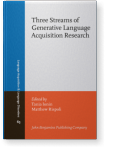Differentiating universal quantification from completive aspect in child Cantonese
The present study examines Cantonese-speaking preschool children’s sensitivity to the distinction between universal quantification (marked by the quantifier verb suffix saai3 ‘all’) and completive aspect (marked by the aspectual verb jyun4 ‘finish’). Using the Truth Value Judgment task and the Picture Selection task, we tested 97 children and 105 adults in a between-subject design on either jyun4-sentences or the corresponding saai3-sentences, paired with a completion (“post-state”) reading and a non-completion (“in-state”) reading. Our findings demonstrate that children systematically distinguish universal quantification from completive aspect, though an incorrect aspectual reading is sometimes assigned to the quantifier affix.
Article outline
- 1.Introduction
- 2.The aspectual verb jyun4 ‘finish’ and the universal A-quantifier saai3 ‘all’ in Cantonese
- 2.1The aspectual verb jyun4 ‘finish’
- 2.2The universal A-quantifier saai3 ‘all’
- 3.Cantonese-speaking children’s early knowledge of jyun4 ‘finish’ and saai3 ‘all’
- 4.The learning tasks for Cantonese-speaking children
- 5.Method
- 5.1Participants
- 5.2Test materials and experiment design
- 5.3Procedure
- 5.4Predictions
- 6.Results
- 6.1Children’s comprehension of the aspectual verb jyun4 ‘finish’
- Results of the Truth Value Judgment task
- Results of the Picture Selection task
- 6.2Children’s comprehension of the universal A-quantifier saai3
- Results of the Truth Value Judgment task
- Results of the Picture Selection task
- 7.Overall discussion
- 8.Conclusions
-
Acknowledgment
-
Notes
-
References
-
Appendix
